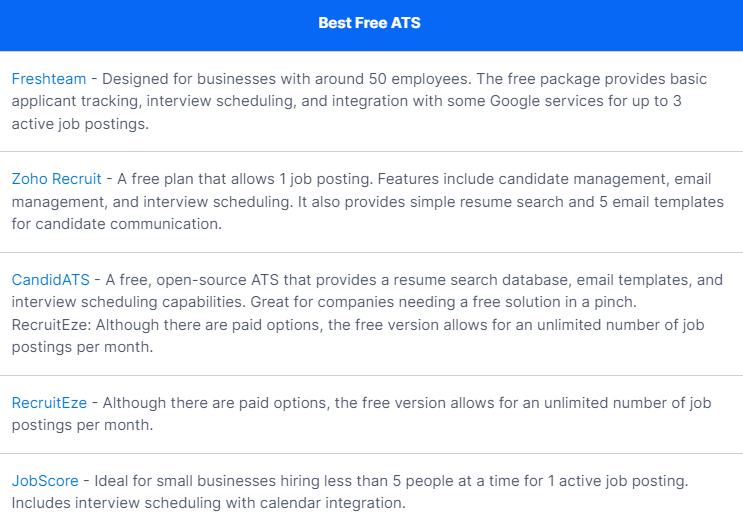What Is an Applicant Tracking System?
Reading Time:
Reading Time:

An Applicant Tracking System (ATS) is software designed to streamline recruiting by filtering and organizing applicant information.
An ATS acts as a database that stores an applicant's contact information, resume, and cover letter, and it can also help you schedule follow-up conversations and interviews.
Essentially, an ATS aims to simplify the hiring process for recruiters and HR managers.
From an applicant's perspective, an ATS typically replaces the traditional paper or email application. (These days, most companies no longer have time to manually review resumes and cover letters.)
First, applicants answer screening questions related to level of education, years of work experience, proficiency in specific programs, and willingness to travel or relocate.
Applicants are then asked to upload their CV, cover letter and additional work samples.
To comply with employment regulations, applicant tracking systems often ask candidates for demographic information, U.S. citizenship status, veteran status, and disability status.
The process typically ends with candidates being given the opportunity to review and submit the application. If this process sounds familiar, you've probably gone through an ATS before!
An applicant tracking system collects and stores all incoming applications in an organized database for employers.
Some resumes are immediately filtered out if they do not contain relevant keywords or if the applicant fails the screening questions. From there, employers can use various features to sort resumes and connect with qualified applicants.
Additionally, an ATS can schedule interviews and handle onboarding once a candidate is hired.
Applicant tracking systems are helpful for companies of all sizes - especially those looking to automate the hiring process and find the best applicants.
An ATS not only stores applicant data, but allows employers to filter and organize applications and communicate with applicants.
Here are the key features of most applicant tracking systems.
Every ATS is different, so features may vary depending on the software used.
Questions about screening
Many applicant management systems offer the option of inserting control questions as part of the application process.
Applicants whose answers do not match the specific qualifications of the position will be filtered out.
View the application
Some employers choose to screen all incoming applications. With the help of applicant management systems, employers can view these applications at any time.
Classifications
Applicant tracking systems automatically rank resumes based on their relevance to the job description. The more keywords that apply to the job description - and the more frequently those keywords appear - the higher the resume will rank on the list.
This makes it easier to determine which applicants are best qualified for the position.
Search for keywords
Employers can search for specific applications using keywords. For example, an employer may search for resumes that contain keywords such as “leadership skills,” “communication skills,” or “customer service.”
CV analysis
An ATS takes information from resumes and converts it into machine-readable formats. The data is structured into different fields and parameters for easier organization.
Resumes storage
An ATS stores resumes over time so that an applicant's information is always on file. Even if an applicant is rejected for a current position, they may be considered for future open positions.
filter
Employers can filter applications based on various parameters, e.g. B. by the applicant's location, the application source and the application date.
Publication on job boards
Some applicant tracking systems even allow employers to post positions on job boards and social media sites. This way, they can easily publicize the job opening and encourage more candidates to apply.
Follow-up communication
Employers can individually design follow-up communication with applicants. For example, employers can automate rejection letters for unqualified applicants or invite qualified applicants for interviews.
Employers should use this feature to ensure that every applicant receives a response to their application.
Background screening
To further streamline the hiring process, some applicant tracking systems also offer background checks.
Companies of all sizes use applicant tracking systems. A recent 2020 study found that 98% of Fortune 500 companies and 66% of large enterprises use an ATS.
Even 35% of small businesses have started using them!
If your company has several positions to fill at the same time or you receive hundreds of applications per advertisement, an ATS can be a sensible investment.
Below you will find some reasons for using an ATS.
Save time: Applicant tracking systems streamline the hiring process. Applications are organized, filtered and stored to make hiring easier. In addition, employers no longer have to check each individual application manually! To further streamline the process, the ATS guides job seekers through the application process and presents you with the most qualified candidates. It also saves applicants time by allowing a step-by-step application process.
Find better candidates: Screening questions quickly narrow down candidates and show you who is best qualified. For example, For example, applicants who only have a high school diploma are immediately filtered out if your position requires a certain level of education - e.g. B. a bachelor's degree. Advanced features can help you identify applicants with the right skills, experience and qualifications for the job.
They help you comply with employment laws: An ATS provides legal documents that are up to date with hiring regulations. You can access these documents at any time to demonstrate the validity of your hiring decisions.
Qualified applicants could be filtered out: Not everyone knows how applicant tracking systems work. If a qualified applicant has not optimized their resume, their application may be rejected. For this reason, employers may still want to review applications manually.
Technical Issues: Some applicant tracking systems are very picky about resume formats and file types. If the ATS cannot open the file or if the resume is too visually complex for the ATS, the resume may be discarded.
Cost considerations: Costs can be a problem for small business owners. Prices and packages vary from ATS to ATS; Find out beforehand how much you are willing or able to spend. Although most applicant tracking systems require monthly fees, there are also free alternatives.
If you've decided to integrate an applicant tracking system into your company but don't know where to start, we've got you covered.
Here you will find some of the best applicant tracking systems on the market.

Numerous applicant tracking systems are available, each with its own features and pricing packages.
Some applicant tracking systems even begin with 2-week free trials.
If you want to recruit the best talent and streamline the application process, an ATS is an excellent investment for your company.

Each of these free options can be upgraded to paid plans.
Free applicant tracking systems are a great way to familiarize yourself with the programs and secure talent in a pinch. Many small businesses begin with free plans and upgrade to paid packages.
An applicant tracking system is a powerful tool but can be overwhelming for first-time users. And with so many options available, how do you know which one will be the best for your business?
Here are a few tips to make the most of an ATS.
Make sure the ATS you choose fits your needs.
Depending on the size of your business, you may need a more robust ATS that aligns with your company goals.
Be sure to learn about the different features that come with each ATS.
Remember that features may differ between free and paid applicant tracking systems.
Here are good questions to guide your research:
Take your time researching applicant tracking systems if you know other business owners who use applicant tracking systems, getting feedback on which software they use is a good idea.
Pro-Tip: With all this research, it’s easy to go into information overload. Narrow down your options by immediately discounting applicant tracking systems that do not meet your requirements. Your final consideration list should contain no more than five applicant tracking systems. From there, rank the applicant tracking systems from most likely to least likely to use, and begin testing the software to make sure it’s a good fit.
It’s a good idea to use free trial versions of different applicant tracking systems.
Typically, an ATS will allow you a certain number of days to try the software before moving to a paid plan.
Take time to familiarize yourself with the software and decide if the features are right for you.
If you find that your top choice doesn’t work for you, go back to your consideration list and try the second option.
Always have a backup plan in case your first choice doesn’t work out!
An ATS will not be useful if you are not attracting the right candidates from the start.
Make sure to use relevant keywords in your job description so qualified candidates will apply.
Decide which skills are most important to the job and include those as keywords for your ATS to track.
From there, your ATS will weed out candidates who are not a good match and rank candidates who match your desired skills and experiences.
With so many applicants these days searching for jobs on cell phones, it is crucial to have a mobile-friendly application process.
Try to keep the application short and sweet.
When possible, avoid long essays. Essays are difficult for the ATS to sort, and you must read through each essay yourself.
Consider short answer responses instead. Candidates may drop out of the application if the process is too long.
Also, keep the ATS simple for yourself!
Customize your ATS to rank critical areas of interest like skills, job experience, or education. An ATS can be overwhelming, so make sure you review only the most vital information from applicants.
In addition to storing an applicant’s resume and cover letter, an ATS may also track information about where your applicants are applying from.
This can show you if one job board attracts more candidates than others.
From there, you can decide where to focus your job posts.
You may also decide to expand your listing to other sites. A more advanced ATS may even identify when a job description could be limiting the types of applicants you receive.
Applicant tracking systems come with an assortment of features to keep you organized.
The more your hiring process happens in one system, the more streamlined and efficient it will be.
Jon Hill, CEO of The Energists, suggests revising your hiring process from top to bottom to integrate the ATS in every way you can.
Take advantage of the analysis capabilities to further improve it as you go.
Darren Dean, the founder of WipeLock, reminds us that applicant tracking systems are designed to help us make decisions, not command us what to do.
Although an ATS can automate tasks and assist recruiters in daily operations, it is important to remember the human aspect behind every hiring endeavor.
Take the time to review qualified candidates and send appropriate follow-up communication.
Schedule preliminary screening interviews with candidates you are interested in.
Keep in mind some candidates may slip through the cracks—reach out to them and see if their personality is a good fit, even if their resume did not make a list.
You can still review resumes to make sure qualified candidates do not get blocked by the ATS.
You should also take detailed notes during each step of the hiring process.
Taking notes keeps you organized and helps you remember details about each candidate.
Most importantly, ensure all hiring personnel is fully trained on the new software and that you are taking advantage of its full capabilities.
Remember: it’s the ATS’s job to keep things organized—it’s your job to hire the best candidates ultimately.